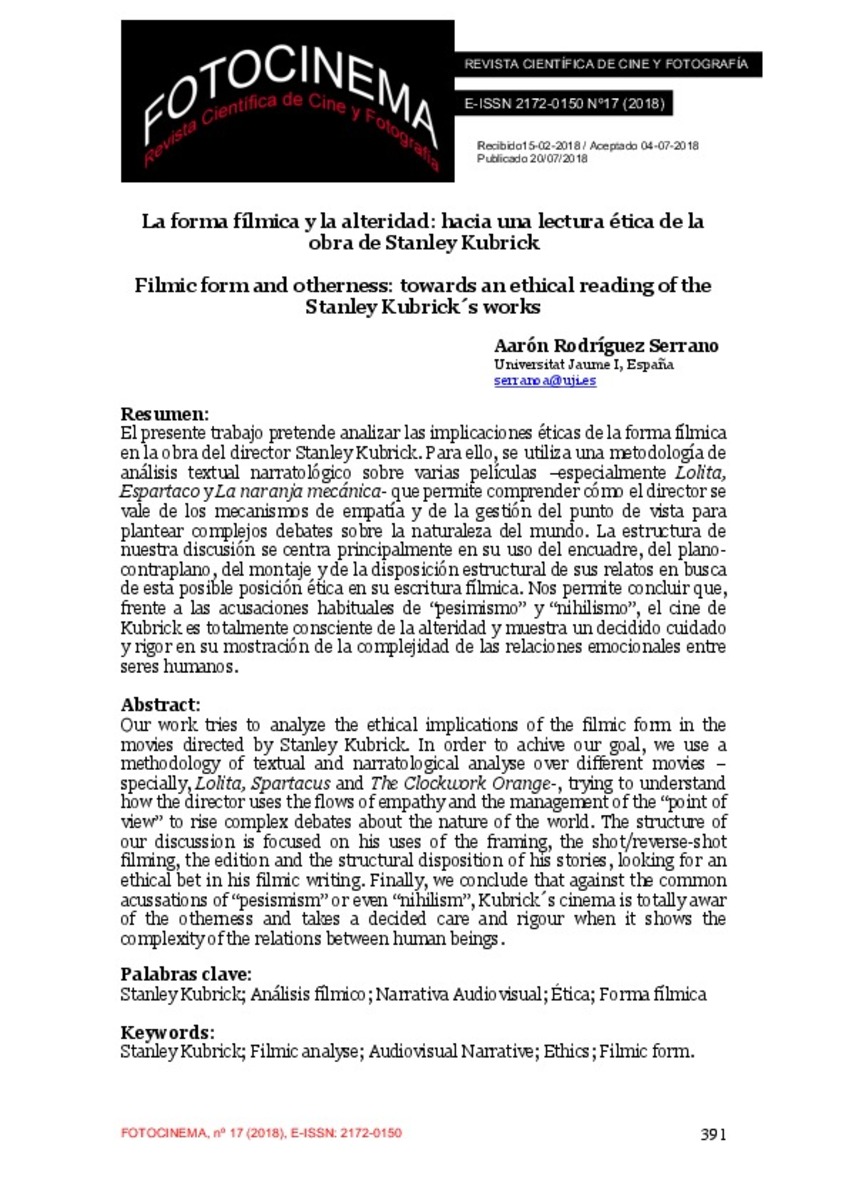Mostrar el registro sencillo del ítem
La forma fílmica y la alteridad: hacia una lectura ética de la obra de Stanley Kubrick
| dc.contributor.author | Rodríguez Serrano, Aarón | |
| dc.date.accessioned | 2018-10-22T08:44:41Z | |
| dc.date.available | 2018-10-22T08:44:41Z | |
| dc.date.issued | 2018-07-20 | |
| dc.identifier.citation | RODRÍGUEZ SERRANO, Aarón (2018). La forma fílmica y la alteridad: hacia una lectura ética de la obra de Stanley Kubrick. Fotocinema, n. 17, p. 391-412 | ca_CA |
| dc.identifier.uri | http://hdl.handle.net/10234/176875 | |
| dc.description.abstract | Our work tries to analyze the ethical implications of the filmic form in the movies directed by Stanley Kubrick. In order to achive our goal, we use a methodology of textual and narratological analyse over different movies – specially, Lolita, Spartacus and The Clockwork Orange - , trying to understand how the director uses the flows of empathy and the management of the “point of view” to rise complex debates about the nature of the world. The structure of our discussion is foc used on his uses of the framing, the shot/reverse - shot filming, the edition and the structural disposition of his stories, looking for an ethical bet in his filmic writing. Finally, we conclude that against the common acussations of “pesismism” or even “ni hilism”, Kubrick ́s cinema is totally awar of the otherness and takes a decided care and rigour when it shows the complexity of the relations between human beings. | ca_CA |
| dc.description.abstract | El presente trabajo pretende analizar las implicaciones éticas de la forma fílmica en la obra del director Stanley Kubrick. Para ello, se utiliza una metodología de an álisis textual narratológico sobre varias películas – especialmente Lolita, Espartaco y La naranja mecánica - que permite comprender cómo el director se vale de los mecanismos de empatía y de la gestión del punto de vista para plantear complejos debates sobr e la naturaleza del mundo. La estructura de nuestra discusión se centra principalmente en su uso del encuadre, del plano - contraplano, del montaje y de la disposición estructural de sus relatos en busca de esta posible posición ética en su escritura fílmica . Nos permite concluir que, frente a las acusaciones habituales de “pesimismo” y “nihilism o”, el cine de Kubrick es total mente consciente de la alteridad y muestra un decidido cuidado y rigor en su mostración de la complejidad de las relaciones emocionales entre seres humanos | ca_CA |
| dc.format.extent | 22 p. | ca_CA |
| dc.format.mimetype | application/pdf | ca_CA |
| dc.language.iso | spa | ca_CA |
| dc.publisher | Universidad de Málaga | ca_CA |
| dc.relation.isPartOf | Fotocinema (2018), n. 17 | ca_CA |
| dc.rights | Attribution-NonCommercial-NoDerivatives 4.0 Internacional | * |
| dc.rights.uri | http://creativecommons.org/licenses/by-nc-nd/4.0/ | * |
| dc.subject | Stanley Kubrick | ca_CA |
| dc.subject | Filmic analyse | ca_CA |
| dc.subject | Audiovisual Narrative | ca_CA |
| dc.subject | Ethics | ca_CA |
| dc.subject | Filmic form | ca_CA |
| dc.subject | Análisis fílmico | ca_CA |
| dc.subject | Narrativa Audiovisual | ca_CA |
| dc.subject | Ética | ca_CA |
| dc.subject | Forma fílmica | ca_CA |
| dc.title | La forma fílmica y la alteridad: hacia una lectura ética de la obra de Stanley Kubrick | ca_CA |
| dc.title.alternative | Filmic form and otherness: towards an ethical reading of the Stanley Kubrick ́s works | ca_CA |
| dc.type | info:eu-repo/semantics/article | ca_CA |
| dc.rights.accessRights | info:eu-repo/semantics/openAccess | ca_CA |
| dc.relation.publisherVersion | http://www.revistafotocinema.com/index.php?journal=fotocinema&page=article&op=view&path%5B%5D=479 | ca_CA |
| dc.type.version | info:eu-repo/semantics/publishedVersion | ca_CA |
Ficheros en el ítem
Este ítem aparece en la(s) siguiente(s) colección(ones)
-
COM_Articles [808]








